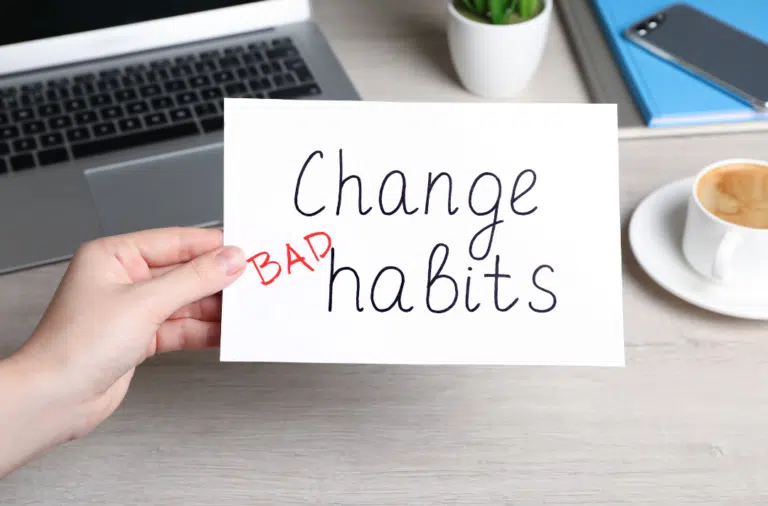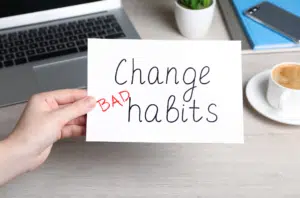How to Change Bad Habits
Habits are the invisible architecture of our daily lives, significantly impacting our well-being and success. The good (and the bad) thing about habits is that after repeatedly engaging in them, they become automatic. These sneaky patterns can lead to sabotaging your success. Not only can unhealthy habits hold you back, they are extra tricky because you may not even be aware you are doing them!
Once you know the things that stand in your way and the things that help you, consider what changes will help support your efforts to replace unhealthy habits with healthier ones.
Following our exploration of building healthy habits, let’s now delve into transforming negative habits, through the lens of Jane’s experience. Jane, a successful entrepreneur, found herself in a relentless cycle of late-night work and caffeine-fueled mornings. This routine, initially a way to keep up with her demanding career, began to undermine her health and happiness.
Unraveling the Negative Habit Loop
Each habit, good or bad, serves a purpose. It meets a need or fills a void. Unhealthy habits often provide immediate gratification but at the cost of long-term detriment. They are born from cues like boredom, stress, or fatigue and lead to routines offering temporary relief but no lasting satisfaction. Identifying this underlying need is key. Understanding this can guide you toward healthier alternatives that fulfill the same need more effectively.
Breaking a bad habit involves disrupting the current loop and establishing a new, healthier one. It involves identifying the cue and consciously choosing an alternative routine that leads to a more satisfying reward.
Step 1: Recognizing the Root
Your journey begins with recognizing the root cause of your negative habits. Why do you engage in these behaviors? Is it a response to stress, boredom, or emotional triggers? The key to transformation lies in understanding the ‘why’ behind our habits.
For Jane, her habit of scrolling through social media when stressed provided immediate gratification but no long-term solution. The first step in changing such habits is recognizing the trigger. Jane’s trigger was the overwhelming stress from her work.
Step 2: Replace the Behavior
One effective method for changing negative habits is the substitution strategy. This involves replacing a negative habit with a positive one that offers a similar reward. For instance, if stress leads you to mindless scrolling on social media, try substituting it with a short meditation or a quick walk. The key is to fulfill the same need in a healthier way.
Jane decided to replace her social media scrolling with healthier activities like short meditation sessions or brisk walks. This substitution strategy meant she was still addressing her need for a break, but in a way that enhanced her well-being.
Important Reminders as You Embark Into Habit Transformation
Embrace Setbacks as Learning Opportunities
Setbacks are an inevitable part of the habit change process. Instead of viewing them as failures, see them as opportunities to learn more about yourself and your triggers. Each setback is a chance to refine your approach and strengthen your resolve.
Jane learned that her habit was more likely to resurface during high-stress periods, enabling her to prepare alternative coping strategies in advance.
Build a Support System
Having a supportive community can greatly enhance your ability to transform negative habits. Share your goals with friends, family, or a support group. Their encouragement and accountability can be powerful motivators in your journey.
Jane found support in a group of fellow entrepreneurs, which provided her with external accountability and encouragement.
Celebrate Progress, Not Perfection
In the pursuit of habit change, focus on progress, not perfection. Celebrating small milestones builds momentum and reinforces positive behavior. Remember, every step forward, no matter how small, is a step in the right direction.
Jane celebrated small milestones, like completing a week without late-night work sessions, which built her momentum and reinforced her new behavior.
The Power of Mindful Choices
In this journey, every decision to engage in a positive habit is a victory. Jane’s story illustrates the transformative power of understanding, planning, and persistence in habit change. It’s not just about changing habits but about personal growth and empowerment.
Embrace Your Transformation
Transforming negative habits isn’t just about discarding old patterns; it’s about embracing a new, empowered way of living. Your journey is unique and requires patience, understanding, and perseverance. Equip yourself with these proven psychological strategies and step forward into a life where each day is a reflection of your best self.








